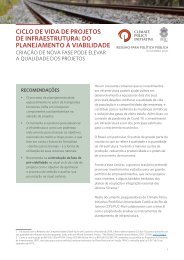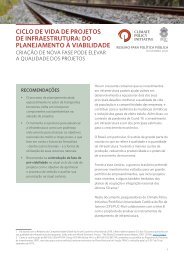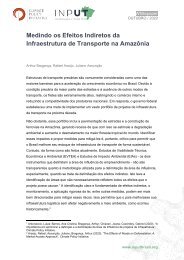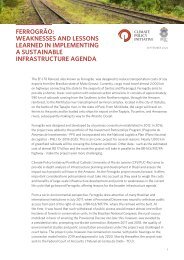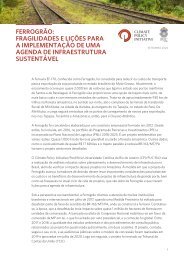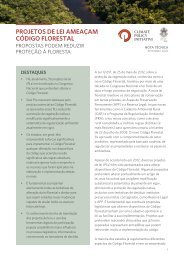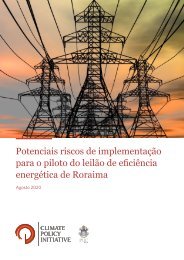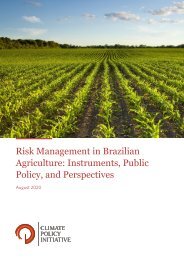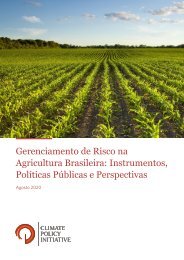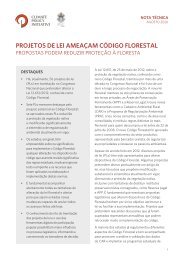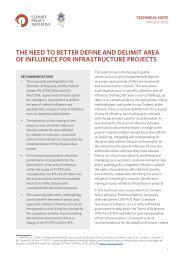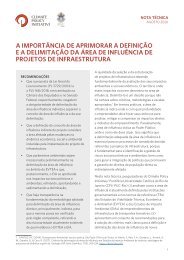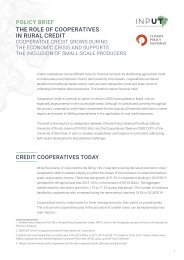The Impacts of Rural Credit on Agricultural Outcomes and Land Use
You also want an ePaper? Increase the reach of your titles
YUMPU automatically turns print PDFs into web optimized ePapers that Google loves.
POLICY BRIEF<br />
<str<strong>on</strong>g>The</str<strong>on</strong>g> <str<strong>on</strong>g>Impacts</str<strong>on</strong>g> <str<strong>on</strong>g>of</str<strong>on</strong>g> <str<strong>on</strong>g>Rural</str<strong>on</strong>g> <str<strong>on</strong>g>Credit</str<strong>on</strong>g><br />
<strong>on</strong> <strong>Agricultural</strong> <strong>Outcomes</strong><br />
<strong>and</strong> L<strong>and</strong> <strong>Use</strong><br />
An Analysis by <str<strong>on</strong>g>Credit</str<strong>on</strong>g> Lines, Producer Types <strong>and</strong> <str<strong>on</strong>g>Credit</str<strong>on</strong>g> <strong>Use</strong>s<br />
Brazil is the world’s largest net exporter <str<strong>on</strong>g>of</str<strong>on</strong>g> agricultural products (FAO, 2016). <str<strong>on</strong>g>The</str<strong>on</strong>g> nati<strong>on</strong>al rural credit<br />
system is crucial for financing agribusiness, with annual credit volume corresp<strong>on</strong>ding to nearly 40%<br />
<str<strong>on</strong>g>of</str<strong>on</strong>g> the nati<strong>on</strong>al agricultural producti<strong>on</strong> value. Brazil’s rural credit policy comprises a complex set <str<strong>on</strong>g>of</str<strong>on</strong>g><br />
funding sources <strong>and</strong> programs, with a policy framework that dates back to the 1960s, when farmers’<br />
needs were quite different than they are today.<br />
Previous analysis c<strong>on</strong>ducted by Climate Policy Initiative/P<strong>on</strong>tifical Catholic University <str<strong>on</strong>g>of</str<strong>on</strong>g> Rio de<br />
Janeiro’s (CPI/PUC-Rio) researchers has evaluated the impacts <str<strong>on</strong>g>of</str<strong>on</strong>g> rural credit <strong>on</strong> agricultural outcomes<br />
<strong>and</strong> l<strong>and</strong> use. <str<strong>on</strong>g>The</str<strong>on</strong>g> empirical evidence shows how rural credit positively boosts producti<strong>on</strong> <strong>and</strong> crop<br />
yields, increases intensificati<strong>on</strong>, <strong>and</strong> reduces pasturel<strong>and</strong> in such a way that it decreases pressures<br />
for deforestati<strong>on</strong>. 1 CPI/PUC-Rio’s work has also highlighted rural credit’s limitati<strong>on</strong>s <strong>and</strong> areas for<br />
improvement. Underst<strong>and</strong>ing how this important policy affects farmers’ decisi<strong>on</strong>s is critical for<br />
designing better financial instruments for agriculture in Brazil.<br />
This analysis aims to provide policymakers with a deeper underst<strong>and</strong>ing <str<strong>on</strong>g>of</str<strong>on</strong>g> rural credit’s impact<br />
al<strong>on</strong>g three important dimensi<strong>on</strong>s: credit lines, producer types, <strong>and</strong> types <str<strong>on</strong>g>of</str<strong>on</strong>g> credit use.<br />
Results from this disaggregated analysis show that the patterns <str<strong>on</strong>g>of</str<strong>on</strong>g> increasing productivity with<br />
reduced deforestati<strong>on</strong> is str<strong>on</strong>ger for smaller farmers. <str<strong>on</strong>g>The</str<strong>on</strong>g> credit associated with large farmers, while<br />
c<strong>on</strong>tributing to increased producti<strong>on</strong> <strong>and</strong> yields, is also associated with expansi<strong>on</strong>s <str<strong>on</strong>g>of</str<strong>on</strong>g> both cropl<strong>and</strong><br />
<strong>and</strong> pastures, leading to higher deforestati<strong>on</strong>. Moreover, productivity increases are also more relevant<br />
for credit associated with small farmers compared to large farmers. <str<strong>on</strong>g>The</str<strong>on</strong>g>se results suggest that for large<br />
l<strong>and</strong>owners increased dem<strong>and</strong> for l<strong>and</strong> is observed when resource efficiency increases. 2 This is not true<br />
for small <strong>and</strong> medium farmers.<br />
Brazil subsidizes rural credit <strong>and</strong> thus should ensure that society reaps broader benefits. Evidence from<br />
this analysis suggests policymakers should prioritize the distributi<strong>on</strong> <str<strong>on</strong>g>of</str<strong>on</strong>g> rural credit to small farmers<br />
as resources for this group increase producti<strong>on</strong> <strong>and</strong> mitigate adverse impacts <strong>on</strong> the envir<strong>on</strong>ment.<br />
Tailoring the rural credit policy towards small producers aligns subsidies with forest c<strong>on</strong>servati<strong>on</strong>.<br />
1 See Assunção <strong>and</strong> Souza (2019), available at https://www.inputbrasil.org/publicacoes/o-impacto-do-credito-rural-na-agriculturabrasileira-e-no-meio-ambiente/?lang=en<br />
2 In ec<strong>on</strong>omics, the so-called Jev<strong>on</strong>s paradox occurs when the efficiency with which a resource is used increases (reducing the<br />
amount necessary for its use), but the use <str<strong>on</strong>g>of</str<strong>on</strong>g> that resource rises due to increased dem<strong>and</strong>.<br />
RECOMMENDATION<br />
To increase agricultural producti<strong>on</strong> <strong>and</strong> mitigate adverse impacts <strong>on</strong> the envir<strong>on</strong>ment, Brazil’s<br />
policymakers should revise the rural credit policy so that credit distributi<strong>on</strong> prioritizes small farmers.<br />
This will better align rural credit subsidies both with the needs <str<strong>on</strong>g>of</str<strong>on</strong>g> financially c<strong>on</strong>strained farmers <strong>and</strong><br />
nati<strong>on</strong>al efforts to increase forest c<strong>on</strong>servati<strong>on</strong>.
2<br />
Moreover, medium <strong>and</strong> large farmers are more likely to be served by unsubsidized credit, especially<br />
with the current lower interest rates in the Brazilian ec<strong>on</strong>omy. <str<strong>on</strong>g>The</str<strong>on</strong>g> analysis in this work also indicates<br />
that credit for larger producers is associated with higher levels <str<strong>on</strong>g>of</str<strong>on</strong>g> deforestati<strong>on</strong>. This highlights the<br />
need for other instruments <strong>and</strong> policies to help c<strong>on</strong>serve Brazil’s natural capital, especially because the<br />
large producers occupy most <str<strong>on</strong>g>of</str<strong>on</strong>g> the agricultural l<strong>and</strong>.<br />
THREE DIMENSIONS OF THE RURAL CREDIT ANALYSIS<br />
This analysis evaluates the impacts <str<strong>on</strong>g>of</str<strong>on</strong>g> rural credit from three perspectives: credit lines (PRONAF,<br />
PRONAMP, <str<strong>on</strong>g>Rural</str<strong>on</strong>g> Savings, <strong>and</strong> Compulsory Resources), 3 producer types (individuals <strong>and</strong> firms) <strong>and</strong><br />
credit uses (working capital, investments <strong>and</strong> trade). 4 Figure 1 shows the number <str<strong>on</strong>g>of</str<strong>on</strong>g> credit c<strong>on</strong>tracts,<br />
the credit amounts, <strong>and</strong> the distributi<strong>on</strong> <str<strong>on</strong>g>of</str<strong>on</strong>g> area covered by the credit c<strong>on</strong>tracts in each category for<br />
each <str<strong>on</strong>g>of</str<strong>on</strong>g> these three perspectives.<br />
<str<strong>on</strong>g>The</str<strong>on</strong>g> analysis by credit line focuses <strong>on</strong> the four largest programs <strong>and</strong> funding sources: PRONAF,<br />
PRONAMP, <str<strong>on</strong>g>Rural</str<strong>on</strong>g> Savings (Restricted), <strong>and</strong> Compulsory Resources. Figure 1 shows that these four<br />
credit lines account for 91% <str<strong>on</strong>g>of</str<strong>on</strong>g> the number <str<strong>on</strong>g>of</str<strong>on</strong>g> c<strong>on</strong>tracts, 64% <str<strong>on</strong>g>of</str<strong>on</strong>g> the credit amount, <strong>and</strong> 84% <str<strong>on</strong>g>of</str<strong>on</strong>g> the<br />
area that receives rural credit in Brazil. Notice that the difference in the distributi<strong>on</strong> <str<strong>on</strong>g>of</str<strong>on</strong>g> the number <str<strong>on</strong>g>of</str<strong>on</strong>g><br />
c<strong>on</strong>tracts <strong>and</strong> credit amounts dem<strong>on</strong>strates how unequal the size <str<strong>on</strong>g>of</str<strong>on</strong>g> the c<strong>on</strong>tracts is across categories.<br />
For instance, PRONAF, which is the primary credit source for small farmers, represents 74% <str<strong>on</strong>g>of</str<strong>on</strong>g> the<br />
number <str<strong>on</strong>g>of</str<strong>on</strong>g> c<strong>on</strong>tracts, but <strong>on</strong>ly 14% <str<strong>on</strong>g>of</str<strong>on</strong>g> the credit amount <strong>and</strong> 16% <str<strong>on</strong>g>of</str<strong>on</strong>g> the area.<br />
<str<strong>on</strong>g>The</str<strong>on</strong>g> next dimensi<strong>on</strong> <str<strong>on</strong>g>of</str<strong>on</strong>g> analysis focuses <strong>on</strong> the types <str<strong>on</strong>g>of</str<strong>on</strong>g> producers: individuals <strong>and</strong> firms. <str<strong>on</strong>g>The</str<strong>on</strong>g> high<br />
costs <str<strong>on</strong>g>of</str<strong>on</strong>g> starting a new business in Brazil <strong>and</strong> a special tax regime encourage agricultural producers<br />
to organize <strong>and</strong> present themselves to the tax authority as individuals rather than firms. Again, the<br />
unequal allocati<strong>on</strong> <str<strong>on</strong>g>of</str<strong>on</strong>g> resources across categories st<strong>and</strong>s out: while <strong>on</strong>ly 1% <str<strong>on</strong>g>of</str<strong>on</strong>g> producers are firms,<br />
they account for 29% <str<strong>on</strong>g>of</str<strong>on</strong>g> the credit amount <strong>and</strong> 85% <str<strong>on</strong>g>of</str<strong>on</strong>g> the area that receives credit (see Figure 1).<br />
Finally, the analysis looks at the use <str<strong>on</strong>g>of</str<strong>on</strong>g> credit. <str<strong>on</strong>g>The</str<strong>on</strong>g> rural credit policy in Brazil supports three major<br />
uses <str<strong>on</strong>g>of</str<strong>on</strong>g> credit: working capital, investment, <strong>and</strong> trade. Working capital makes up the major use <str<strong>on</strong>g>of</str<strong>on</strong>g><br />
credit c<strong>on</strong>sidering credit amounts. Figure 1 also shows the credit use for investment is still quite<br />
limited in terms <str<strong>on</strong>g>of</str<strong>on</strong>g> amount (23%) <strong>and</strong> covered area (7%) compared to working capital (57% <strong>and</strong><br />
93%, respectively).<br />
3 <str<strong>on</strong>g>The</str<strong>on</strong>g> PRONAF program is the Nati<strong>on</strong>al Program for Family Farming (Programa Naci<strong>on</strong>al de Fortalecimento da Agricultura Familiar).<br />
<str<strong>on</strong>g>The</str<strong>on</strong>g> PRONAMP program is the Nati<strong>on</strong>al Program to Support Medium Producers (Programa Naci<strong>on</strong>al de Apoio ao Médio Produtor <str<strong>on</strong>g>Rural</str<strong>on</strong>g>).<br />
<str<strong>on</strong>g>Rural</str<strong>on</strong>g> Savings – Restricted (Poupança <str<strong>on</strong>g>Rural</str<strong>on</strong>g> - C<strong>on</strong>trolados) <strong>and</strong> Compulsory Resources (Recursos Obrigatórios - MCR 6.2) are funding<br />
sources with their own financing c<strong>on</strong>diti<strong>on</strong>s. <str<strong>on</strong>g>The</str<strong>on</strong>g> analysis c<strong>on</strong>siders loans from <str<strong>on</strong>g>Rural</str<strong>on</strong>g> Savings-Restricted <strong>and</strong> Compulsory Resources<br />
that are not linked to specific rural credit programs.<br />
4 Although “industry” is also a category for “uses <str<strong>on</strong>g>of</str<strong>on</strong>g> capital” in 2017, it is a small <strong>on</strong>e c<strong>on</strong>sidering the number <str<strong>on</strong>g>of</str<strong>on</strong>g> c<strong>on</strong>tracts <strong>and</strong> the<br />
credit amounts. Besides that, it <strong>on</strong>ly appears in recent years. <str<strong>on</strong>g>The</str<strong>on</strong>g>refore, an ec<strong>on</strong>ometric analysis using panel data for the period 2002-<br />
2017 is not possible.
3<br />
Figure 1: <str<strong>on</strong>g>The</str<strong>on</strong>g> Distributi<strong>on</strong> <str<strong>on</strong>g>of</str<strong>on</strong>g> <str<strong>on</strong>g>Rural</str<strong>on</strong>g> <str<strong>on</strong>g>Credit</str<strong>on</strong>g> in <str<strong>on</strong>g>Credit</str<strong>on</strong>g> Lines, Producer Types <strong>and</strong> Types <str<strong>on</strong>g>of</str<strong>on</strong>g> <str<strong>on</strong>g>Credit</str<strong>on</strong>g> in 2017<br />
Source: Climate Policy Initiative with data from the Brazilian Central Bank
4<br />
METHODOLOGY<br />
Estimating the impact <str<strong>on</strong>g>of</str<strong>on</strong>g> credit <strong>on</strong> agricultural producti<strong>on</strong> <strong>and</strong> l<strong>and</strong> use is a challenging task. It requires<br />
disentangling cause <strong>and</strong> effect <strong>and</strong> isolating the impacts that credit actually has. On the <strong>on</strong>e h<strong>and</strong>,<br />
credit allows farmers to fund the upfr<strong>on</strong>t costs <strong>and</strong> investments necessary for increasing producti<strong>on</strong>.<br />
On the other h<strong>and</strong>, banks tend to focus their operati<strong>on</strong>s <strong>on</strong> farmers with better prospects. <str<strong>on</strong>g>The</str<strong>on</strong>g>refore,<br />
a positive correlati<strong>on</strong> between credit <strong>and</strong> ec<strong>on</strong>omic outcomes does not necessarily imply that credit<br />
causes the observed changes.<br />
In order to address these issues <strong>and</strong> build reliable estimates <str<strong>on</strong>g>of</str<strong>on</strong>g> the impacts <str<strong>on</strong>g>of</str<strong>on</strong>g> credit, the researchers<br />
use a shift-share methodology <strong>on</strong> a dataset with all <str<strong>on</strong>g>of</str<strong>on</strong>g> Brazilian municipalities for the period <str<strong>on</strong>g>of</str<strong>on</strong>g><br />
2002-2017. <str<strong>on</strong>g>The</str<strong>on</strong>g> ec<strong>on</strong>ometric procedure focuses <strong>on</strong> the variati<strong>on</strong> <str<strong>on</strong>g>of</str<strong>on</strong>g> the availability <str<strong>on</strong>g>of</str<strong>on</strong>g> credit that<br />
is the interacti<strong>on</strong> <str<strong>on</strong>g>of</str<strong>on</strong>g> two comp<strong>on</strong>ents: the distributi<strong>on</strong> <str<strong>on</strong>g>of</str<strong>on</strong>g> bank branches across municipalities<br />
<strong>and</strong> the aggregate variati<strong>on</strong> in the source <str<strong>on</strong>g>of</str<strong>on</strong>g> funding for each bank. For instance, if Bank <str<strong>on</strong>g>of</str<strong>on</strong>g> Brazil<br />
(Banco do Brasil) has more resources from rural savings in a given year, the method c<strong>on</strong>siders that<br />
those municipalities with Bank <str<strong>on</strong>g>of</str<strong>on</strong>g> Brazil’s branches are more likely to have more credit available.<br />
<str<strong>on</strong>g>The</str<strong>on</strong>g>se variati<strong>on</strong>s, implemented at scale for all municipalities <strong>and</strong> banks in the period, allow for<br />
the estimati<strong>on</strong> <str<strong>on</strong>g>of</str<strong>on</strong>g> the impacts <str<strong>on</strong>g>of</str<strong>on</strong>g> credit supply <strong>on</strong> the outcome variables (e.g., productivity, l<strong>and</strong><br />
expansi<strong>on</strong>, deforestati<strong>on</strong>, etc.). This strategy for identifying causal impacts is widely used in recent<br />
academic literature.<br />
IMPACT OF RURAL CREDIT<br />
This analysis c<strong>on</strong>siders the impacts <str<strong>on</strong>g>of</str<strong>on</strong>g> credit <strong>on</strong> two sets <str<strong>on</strong>g>of</str<strong>on</strong>g> outcomes: agricultural producti<strong>on</strong> <strong>and</strong><br />
l<strong>and</strong> use change. <str<strong>on</strong>g>The</str<strong>on</strong>g> evidence <strong>on</strong> producti<strong>on</strong> reveals how better credit access allows farmers to<br />
exp<strong>and</strong> their operati<strong>on</strong>s. <str<strong>on</strong>g>The</str<strong>on</strong>g> analysis <strong>on</strong> productivity reveals whether increased credit supply changes<br />
how farmers operate. A change in farming decisi<strong>on</strong>s suggests farmers are financially c<strong>on</strong>strained. If<br />
farmers did not face any financial c<strong>on</strong>straints, credit would not change producti<strong>on</strong> decisi<strong>on</strong>s since<br />
farmers would simply use the increased access to cheaper credit to reduce their cost <str<strong>on</strong>g>of</str<strong>on</strong>g> capital with<br />
no implicati<strong>on</strong>s <strong>on</strong> producti<strong>on</strong>. <str<strong>on</strong>g>The</str<strong>on</strong>g> evidence from this work is that, in most cases, credit has an impact<br />
<strong>on</strong> producti<strong>on</strong> decisi<strong>on</strong>s. However, the results show substantial differences <strong>on</strong> productivity across the<br />
different categories analyzed.<br />
<str<strong>on</strong>g>The</str<strong>on</strong>g> sec<strong>on</strong>d part <str<strong>on</strong>g>of</str<strong>on</strong>g> the analysis looks at the impacts <str<strong>on</strong>g>of</str<strong>on</strong>g> credit <strong>on</strong> l<strong>and</strong> use. <str<strong>on</strong>g>The</str<strong>on</strong>g> results reveal<br />
striking variati<strong>on</strong> in how different farmers use the funds provided by rural credit. <str<strong>on</strong>g>The</str<strong>on</strong>g> credit for<br />
small farmers tends to reduce the pressures <strong>on</strong> deforestati<strong>on</strong> while credit for large farmers leads to<br />
increased deforestati<strong>on</strong>.<br />
AGRICULTURAL PRODUCTION<br />
<str<strong>on</strong>g>The</str<strong>on</strong>g> results <str<strong>on</strong>g>of</str<strong>on</strong>g> the estimati<strong>on</strong> <str<strong>on</strong>g>of</str<strong>on</strong>g> the impacts <str<strong>on</strong>g>of</str<strong>on</strong>g> rural credit <strong>on</strong> producti<strong>on</strong> outcomes are presented in<br />
Figures 2-4, covering all municipalities in the country for the 2002-2017 period. Since the impacts are<br />
associated with how changes in credit supply affect the outcome variables, all graphs represent the<br />
estimated impact <str<strong>on</strong>g>of</str<strong>on</strong>g> a 1% increase in the municipal credit supply for each case. In technical terms, the<br />
estimates are interpreted as elasticities.<br />
<str<strong>on</strong>g>The</str<strong>on</strong>g> analysis by credit line focuses <strong>on</strong> the impact <str<strong>on</strong>g>of</str<strong>on</strong>g> a 1% increase in municipal rural credit supply <str<strong>on</strong>g>of</str<strong>on</strong>g><br />
PRONAF, PRONAMP, <str<strong>on</strong>g>Rural</str<strong>on</strong>g> Savings-Restricted, <strong>and</strong> Compulsory Resources. PRONAF <strong>and</strong> PRONAMP<br />
are associated with small <strong>and</strong> medium farmers respectively, while <str<strong>on</strong>g>Rural</str<strong>on</strong>g> Savings -Restricted <strong>and</strong>
5<br />
Compulsory Resources are mostly associated with large l<strong>and</strong>holders. Figure 2 shows that, in the case<br />
<str<strong>on</strong>g>of</str<strong>on</strong>g> PRONAF, a 1% increase in credit supply leads to the increase in both producti<strong>on</strong> (0.19% in crop<br />
producti<strong>on</strong>, 0.02% in head <str<strong>on</strong>g>of</str<strong>on</strong>g> cattle) <strong>and</strong> productivity (0.10% in crop producti<strong>on</strong> per hectare <strong>and</strong> 0.14%<br />
in head <str<strong>on</strong>g>of</str<strong>on</strong>g> cattle per hectare). For PRONAMP, the impacts are not statistically significant <strong>and</strong> slightly<br />
negative for cattle producti<strong>on</strong>. <str<strong>on</strong>g>The</str<strong>on</strong>g> observed differences across small <strong>and</strong> medium farmers suggest that<br />
PRONAF is alleviating credit c<strong>on</strong>straints for small farmers, while medium farmers do not significantly<br />
change their producti<strong>on</strong> decisi<strong>on</strong>s with the increase in the availability <str<strong>on</strong>g>of</str<strong>on</strong>g> resources. This differential<br />
effect <str<strong>on</strong>g>of</str<strong>on</strong>g> PRONAMP might be because the target farmers are less financially c<strong>on</strong>strained.<br />
In the case <str<strong>on</strong>g>of</str<strong>on</strong>g> <str<strong>on</strong>g>Rural</str<strong>on</strong>g> Savings-Restricted, the increase in credit supply has a positive impact <strong>on</strong><br />
producti<strong>on</strong> (0.13% in crop <strong>and</strong> 0.04% in head <str<strong>on</strong>g>of</str<strong>on</strong>g> cattle) but no impact <strong>on</strong> l<strong>and</strong> productivity, which is<br />
a sign that the borrowers seem to use the funding to increase the extent <str<strong>on</strong>g>of</str<strong>on</strong>g> their activities rather than<br />
changing how they farm their l<strong>and</strong>. Finally, the results <str<strong>on</strong>g>of</str<strong>on</strong>g> Compulsory Resources point to an increase<br />
in producti<strong>on</strong> (0.04% in crops <strong>and</strong> 0.06% in head <str<strong>on</strong>g>of</str<strong>on</strong>g> cattle) <strong>and</strong> a slightly higher crop productivity<br />
(0.04%), but no impact <strong>on</strong> the measure <str<strong>on</strong>g>of</str<strong>on</strong>g> cattle productivity. Thus, the analysis <str<strong>on</strong>g>of</str<strong>on</strong>g> <str<strong>on</strong>g>Rural</str<strong>on</strong>g> Savings -<br />
Restricted <strong>and</strong> Compulsory Resources, which are funds primarily channeled to large farmers, seem to<br />
alleviate financial c<strong>on</strong>straints that prevent farmers from exp<strong>and</strong>ing their operati<strong>on</strong>s, but have much less<br />
impact <strong>on</strong> how they cultivate their l<strong>and</strong>. Notice that the <strong>on</strong>ly impact <strong>on</strong> productivity is much smaller<br />
than those observed in the case <str<strong>on</strong>g>of</str<strong>on</strong>g> PRONAF.<br />
<str<strong>on</strong>g>The</str<strong>on</strong>g> analysis <strong>on</strong> types <str<strong>on</strong>g>of</str<strong>on</strong>g> producers c<strong>on</strong>siders how the impact <str<strong>on</strong>g>of</str<strong>on</strong>g> credit varies according to the way<br />
farmers are organized (see Figure 3). Interestingly, rural credit affects producti<strong>on</strong> <strong>and</strong> productivity for<br />
farmers who operate as individuals, while those who operate as firms are not affected by the increased<br />
credit. <str<strong>on</strong>g>The</str<strong>on</strong>g>se results suggest that farming enterprises are not financially c<strong>on</strong>strained. Farmers who<br />
organize as individuals, <strong>on</strong> the other h<strong>and</strong>, experience both an increase in producti<strong>on</strong> (0.23% in crop<br />
<strong>and</strong> 0.10% in head <str<strong>on</strong>g>of</str<strong>on</strong>g> cattles) <strong>and</strong> productivity (0.15% in crop per hectare <strong>and</strong> 0.23% in head <str<strong>on</strong>g>of</str<strong>on</strong>g> cattle<br />
per hectare) for a 1% increase in credit supply.<br />
<str<strong>on</strong>g>The</str<strong>on</strong>g> analysis <strong>on</strong> uses <str<strong>on</strong>g>of</str<strong>on</strong>g> credit focuses <strong>on</strong> three categories: working capital, investment, <strong>and</strong> trade credit<br />
(see Figure 4). Working capital credit is short run, typically with a durati<strong>on</strong> <str<strong>on</strong>g>of</str<strong>on</strong>g> less than 12 m<strong>on</strong>ths,<br />
<strong>and</strong> used to fund operati<strong>on</strong>al expenditures (opex), while investment credit has a l<strong>on</strong>ger durati<strong>on</strong> <strong>and</strong><br />
is typically used for capital expenditures (capex). Trade credit is also short run, designed mostly to<br />
support farmers to better deal with price fluctuati<strong>on</strong>s <strong>and</strong> avoid selling their products in periods with<br />
low prices.<br />
<str<strong>on</strong>g>The</str<strong>on</strong>g> analysis <str<strong>on</strong>g>of</str<strong>on</strong>g> different credit uses reveals important differences. <str<strong>on</strong>g>The</str<strong>on</strong>g> impacts <str<strong>on</strong>g>of</str<strong>on</strong>g> working capital <strong>and</strong><br />
investment credit supply vary between crops <strong>and</strong> cattle ranching. In the case <str<strong>on</strong>g>of</str<strong>on</strong>g> crops, both working<br />
capital <strong>and</strong> investment credits affect crop producti<strong>on</strong> <strong>and</strong> crop productivity, suggesting these resources<br />
are supporting farmers to both exp<strong>and</strong> their business <strong>and</strong> change how they cultivate, improving yields.<br />
In the case <str<strong>on</strong>g>of</str<strong>on</strong>g> cattle ranching, credit does not induce an expansi<strong>on</strong> in producti<strong>on</strong>, but rather, an increase<br />
in productivity, especially in the case <str<strong>on</strong>g>of</str<strong>on</strong>g> investment (a 1% increase in credit for investment leads to<br />
a 0.19% increase in cattle productivity). As expected, trade credit does not have relevant impacts <strong>on</strong><br />
agricultural producti<strong>on</strong> or productivity.
6<br />
Figure 2: Impact <str<strong>on</strong>g>of</str<strong>on</strong>g> <str<strong>on</strong>g>Rural</str<strong>on</strong>g> <str<strong>on</strong>g>Credit</str<strong>on</strong>g> <strong>on</strong> <strong>Agricultural</strong> Producti<strong>on</strong> by <str<strong>on</strong>g>Credit</str<strong>on</strong>g> Lines<br />
Source: Climate Policy Initiative with data from the Brazilian Central Bank
7<br />
Figure 3: Impact <str<strong>on</strong>g>of</str<strong>on</strong>g> <str<strong>on</strong>g>Rural</str<strong>on</strong>g> <str<strong>on</strong>g>Credit</str<strong>on</strong>g> <strong>on</strong> <strong>Agricultural</strong> Producti<strong>on</strong> by Type <str<strong>on</strong>g>of</str<strong>on</strong>g> Client<br />
Source: Climate Policy Initiative with data from the Brazilian Central Bank<br />
Figure 4: Impact <str<strong>on</strong>g>of</str<strong>on</strong>g> <str<strong>on</strong>g>Rural</str<strong>on</strong>g> <str<strong>on</strong>g>Credit</str<strong>on</strong>g> <strong>on</strong> <strong>Agricultural</strong> Producti<strong>on</strong> by Type <str<strong>on</strong>g>of</str<strong>on</strong>g> <str<strong>on</strong>g>Credit</str<strong>on</strong>g><br />
Source: Climate Policy Initiative with data from the Brazilian Central Bank
8<br />
LAND USE<br />
<str<strong>on</strong>g>The</str<strong>on</strong>g> results <str<strong>on</strong>g>of</str<strong>on</strong>g> the ec<strong>on</strong>ometric analysis <str<strong>on</strong>g>of</str<strong>on</strong>g> the impacts <str<strong>on</strong>g>of</str<strong>on</strong>g> credit <strong>on</strong> l<strong>and</strong> use reveal marked differences<br />
in how farmers use rural credit resources <strong>on</strong> areas dedicated to crops <strong>and</strong> pasture. For PRONAF, an<br />
increase in rural credit leads to the c<strong>on</strong>versi<strong>on</strong> <str<strong>on</strong>g>of</str<strong>on</strong>g> pastures to cropl<strong>and</strong>s <strong>and</strong> results in a decrease<br />
in total farming area, showing that credit associated with small producers leads to more intensive<br />
agriculture <strong>and</strong> reduces deforestati<strong>on</strong> pressures (see Figure 5). C<strong>on</strong>sequently, credit associated with<br />
PRONAF leads to a (slight) increase in preserved forest areas. More specifically, a 1% increase in<br />
PRONAF credit at the municipal level leads to an expansi<strong>on</strong> in crop area by 0.09% <strong>and</strong> a decrease in<br />
pasture area by 0.12%. <str<strong>on</strong>g>The</str<strong>on</strong>g> result is a 0.03 increase in forest area, which is likely a c<strong>on</strong>sequence <str<strong>on</strong>g>of</str<strong>on</strong>g><br />
lower deforestati<strong>on</strong>. <str<strong>on</strong>g>The</str<strong>on</strong>g>refore, credit for small producers is associated with more efficient l<strong>and</strong> use<br />
<strong>and</strong> higher envir<strong>on</strong>mental c<strong>on</strong>servati<strong>on</strong>, which is beneficial for society.<br />
In c<strong>on</strong>trast, this positive effect <strong>on</strong> forest area is not observed for the other three credit lines analyzed<br />
(PRONAMP, <str<strong>on</strong>g>Rural</str<strong>on</strong>g> Savings-Restricted, <strong>and</strong> Compulsory Resources). Farming areas exp<strong>and</strong> for<br />
PRONAMP (0.02%), <str<strong>on</strong>g>Rural</str<strong>on</strong>g> Savings-Restricted (0.02%) <strong>and</strong> Compulsory Resources (0.04%).<br />
In the same directi<strong>on</strong> <str<strong>on</strong>g>of</str<strong>on</strong>g> the results for credit lines, the impact <str<strong>on</strong>g>of</str<strong>on</strong>g> rural credit <strong>on</strong> l<strong>and</strong> use shows a very<br />
different pattern for individuals <strong>and</strong> firms (see Figure 6). A 1% increase in rural credit for individuals<br />
leads to a 0.09% increase in crop area <strong>and</strong> a 0.13% decrease in pasture area, resulting in a small<br />
increase in forested area (0.01%). However, an increase in rural credit for firms, which are large<br />
borrowers, leads to an expansi<strong>on</strong> <str<strong>on</strong>g>of</str<strong>on</strong>g> both crop (0.02%) <strong>and</strong> pasture (0.04%) areas. <str<strong>on</strong>g>The</str<strong>on</strong>g>refore, the<br />
positive results in terms <str<strong>on</strong>g>of</str<strong>on</strong>g> envir<strong>on</strong>mental c<strong>on</strong>servati<strong>on</strong> are associated with rural credit for individual<br />
borrowers, not for firms.<br />
Finally, c<strong>on</strong>sidering the uses <str<strong>on</strong>g>of</str<strong>on</strong>g> capital, the impacts <str<strong>on</strong>g>of</str<strong>on</strong>g> credit <strong>on</strong> l<strong>and</strong> use are similar for working<br />
capital <strong>and</strong> investments (see Figure 7). In both cases, an increase in rural credit is associated with the<br />
c<strong>on</strong>versi<strong>on</strong> <str<strong>on</strong>g>of</str<strong>on</strong>g> pastures into cropl<strong>and</strong>, resulting in reducti<strong>on</strong>s in farming area <strong>and</strong> increases in forest<br />
preservati<strong>on</strong>. L<strong>and</strong> use change is not seen in credit used for trade.
9<br />
Figure 5: Impact <str<strong>on</strong>g>of</str<strong>on</strong>g> <str<strong>on</strong>g>Rural</str<strong>on</strong>g> <str<strong>on</strong>g>Credit</str<strong>on</strong>g> <strong>on</strong> L<strong>and</strong> <strong>Use</strong> by <str<strong>on</strong>g>Credit</str<strong>on</strong>g> Lines<br />
Source: Climate Policy Initiative with data from the Brazilian Central Bank
10<br />
Figure 6: Impact <str<strong>on</strong>g>of</str<strong>on</strong>g> <str<strong>on</strong>g>Rural</str<strong>on</strong>g> <str<strong>on</strong>g>Credit</str<strong>on</strong>g> <strong>on</strong> L<strong>and</strong> <strong>Use</strong> by Type <str<strong>on</strong>g>of</str<strong>on</strong>g> Client<br />
Source: Climate Policy Initiative with data from the Brazilian Central Bank<br />
Figure 7: Impact <str<strong>on</strong>g>of</str<strong>on</strong>g> <str<strong>on</strong>g>Rural</str<strong>on</strong>g> <str<strong>on</strong>g>Credit</str<strong>on</strong>g> <strong>on</strong> L<strong>and</strong> <strong>Use</strong> by Type <str<strong>on</strong>g>of</str<strong>on</strong>g> <str<strong>on</strong>g>Credit</str<strong>on</strong>g><br />
Source: Climate Policy Initiative with data from the Brazilian Central Bank
11<br />
CONCLUSION<br />
This policy brief builds <strong>on</strong> previous evidence from CPI/PUC-Rio that shows that rural credit in<br />
Brazil boosts producti<strong>on</strong> <strong>and</strong> crop yields <strong>and</strong> intensifies agricultural producti<strong>on</strong> in such a way that<br />
deforestati<strong>on</strong> pressure decreases. Here, the impacts <str<strong>on</strong>g>of</str<strong>on</strong>g> rural credit are detailed across three relevant<br />
dimensi<strong>on</strong>s: credit lines, types <str<strong>on</strong>g>of</str<strong>on</strong>g> producers, <strong>and</strong> uses for credit.<br />
Results show that the average impacts <str<strong>on</strong>g>of</str<strong>on</strong>g> Brazilian rural credit—with patterns <str<strong>on</strong>g>of</str<strong>on</strong>g> increasing<br />
productivity while reducing deforestati<strong>on</strong>—are more predominant for credit associated with small<br />
farmers. <str<strong>on</strong>g>The</str<strong>on</strong>g> credit for large farmers, while c<strong>on</strong>tributing to increasing producti<strong>on</strong> <strong>and</strong> yields, also leads<br />
to an expansi<strong>on</strong> <str<strong>on</strong>g>of</str<strong>on</strong>g> cropl<strong>and</strong> <strong>and</strong> pastures, resulting in higher deforestati<strong>on</strong>. Moreover, productivity<br />
increases are more relevant for credit associated with small farmers compared to larger farmers.<br />
Policymakers should prioritize small farmers in the rural credit policy to increase producti<strong>on</strong> <strong>and</strong><br />
l<strong>and</strong> productivity <strong>and</strong> mitigate adverse impacts <strong>on</strong> the envir<strong>on</strong>ment. Tailoring the rural credit policy<br />
toward this goal aligns subsidies with forest c<strong>on</strong>servati<strong>on</strong> <strong>and</strong> fits in a scenario in which medium <strong>and</strong><br />
large farmers are more likely to be served by unsubsidized credit, especially in the Brazilian c<strong>on</strong>text <str<strong>on</strong>g>of</str<strong>on</strong>g><br />
lower interest rates. Moreover, since credit for large producers is associated with higher deforestati<strong>on</strong><br />
<strong>and</strong> this group occupies most <str<strong>on</strong>g>of</str<strong>on</strong>g> the country's agricultural l<strong>and</strong>, other instruments <strong>and</strong> policies are<br />
necessary to encourage forest c<strong>on</strong>servati<strong>on</strong>.<br />
AUTHORS<br />
Juliano Assunção<br />
Executive Director<br />
Climate Policy Initiative/P<strong>on</strong>tifical Catholic University<br />
<str<strong>on</strong>g>of</str<strong>on</strong>g> Rio de Janeiro (CPI/PUC-Rio)<br />
Associate Pr<str<strong>on</strong>g>of</str<strong>on</strong>g>essor, Department <str<strong>on</strong>g>of</str<strong>on</strong>g> Ec<strong>on</strong>omics, PUC-Rio<br />
juliano.assuncao@cpirio.org<br />
Priscila Souza<br />
Head <str<strong>on</strong>g>of</str<strong>on</strong>g> Policy Evaluati<strong>on</strong>, Financial Instruments<br />
Climate Policy Initiative/P<strong>on</strong>tifical Catholic University<br />
<str<strong>on</strong>g>of</str<strong>on</strong>g> Rio de Janeiro (CPI/PUC-Rio)<br />
priscila.souza@cpirio.org<br />
Suggested Citati<strong>on</strong><br />
ASSUNÇÃO, Juliano; SOUZA, Priscila. Policy Brief. <str<strong>on</strong>g>The</str<strong>on</strong>g> <str<strong>on</strong>g>Impacts</str<strong>on</strong>g> <str<strong>on</strong>g>of</str<strong>on</strong>g> <str<strong>on</strong>g>Rural</str<strong>on</strong>g> <str<strong>on</strong>g>Credit</str<strong>on</strong>g> <strong>on</strong> <strong>Agricultural</strong> <strong>Outcomes</strong> <strong>and</strong> L<strong>and</strong><br />
<strong>Use</strong>: An Analysis by <str<strong>on</strong>g>Credit</str<strong>on</strong>g> Lines, Producer Types <strong>and</strong> <str<strong>on</strong>g>Credit</str<strong>on</strong>g> <strong>Use</strong>s. Rio de Janeiro: Climate Policy Initiative, 2020.<br />
March 2020<br />
Climate Policy Initiative (CPI) works to improve the most important energy <strong>and</strong> l<strong>and</strong> use policies around the world. We support decisi<strong>on</strong><br />
makers through in-depth analysis <strong>on</strong> what works <strong>and</strong> what does not. CPI’s Brazil program partners with the P<strong>on</strong>tifical Catholic University <str<strong>on</strong>g>of</str<strong>on</strong>g><br />
Rio de Janeiro (PUC-Rio). This work is funded by the World Wild Fund (WWF).<br />
www.climatepolicyinitiative.org<br />
C<strong>on</strong>tent licensed under Creative Comm<strong>on</strong>s Attributi<strong>on</strong> 4.0 Internati<strong>on</strong>al.<br />
<str<strong>on</strong>g>The</str<strong>on</strong>g> texts in this publicati<strong>on</strong> may be reproduced in whole or in part<br />
provided that the source <strong>and</strong> the respective authors are cited.




